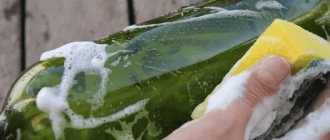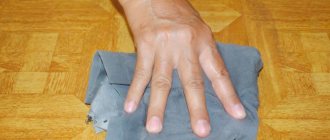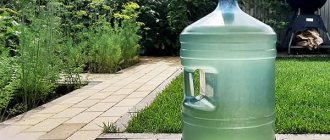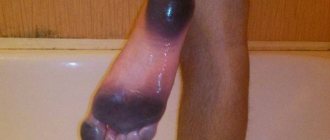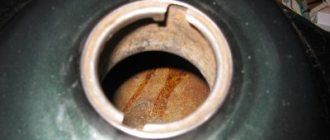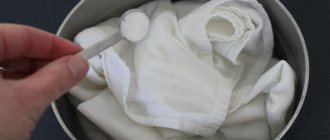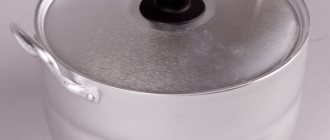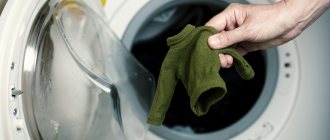How to clean the inside of a carafe?
To manually clean a water jug from plaque and not damage the crystal, you can use available products and food products. To prevent the vessel from becoming cloudy, it is also important to observe the temperature regime. The most effective cleaning methods are using salt, baking soda or vinegar, which completely remove dirt and also leave the glass clear and shiny.
Video material
Periodically wash your jug with acids or using other products suggested in this article, and it will always shine like crystal!
It is rare that someone has not encountered the need to wash the inside of a jug, vase or decanter. This is a very painstaking task, especially if the dishes are convex and have a narrow neck. The hand can’t get through, the brush only reaches the bottom, and the side walls remain dirty. There are proven ways to easily clean the inside of a carafe.
How to wash properly?
When using a dishwasher, you should set the temperature to the lowest possible temperature, as well as a special mode designed for glassware. However, constant use of the technique will cause the decanter to lose its shine.
To minimize the risk of glass damage, as well as to completely clean the vessel, you must adhere to the following rules:
- Warm water should be used for washing. A sharp change from high to low temperature, which provokes a gradual darkening of the glass, is especially dangerous for crystal.
- All rings and bracelets are removed so as not to scratch the walls.
- It is best to wash the decanter not in the sink, but in a plastic basin. As an alternative, it is recommended to place a soft rubber mat. However, the water should be changed constantly to prevent staining of the glass.
- You need to start washing the decanter from the outside, and then move on to the inner walls.
- It is best to use a soft bristle brush or sponge.
- A damp glass decanter or vase should be wiped with a soft cloth. If the neck of the vessel allows, it is recommended to place paper towels inside for 8-10 hours. During this time, all the resulting moisture will be absorbed. Do not leave the container to dry on the rack.
Return to contents
What kind of filter do you have at home?
In apartments and private houses, three types of filters are most often used:
- reverse osmosis systems;
- flow-through;
- jugs.
Reverse osmosis
The first type includes Geyser filters. They are good if you have to purify significant volumes of water - for example, for a large family. Install such a system in a carafe, in the kitchen or bathroom.
Important! It itself is quite large, however, it does not spoil the interior at all. It is almost invisible from the outside; all large parts are put away under the sink. This is the only type of cleaning in which scale does not form on the walls of the kettle.
Its main advantage is maximum cleaning. There are, of course, disadvantages:
- high price;
- professional installation required;
- installation takes time;
- such a filter does not protect household appliances from scale;
- There is a metallic taste in the water.
Flow filters
Such a device is cheaper than a reverse osmosis system. There is no need to boil the water either. The flow filter is smaller and easy to transport. They come in different sizes, and some also take a long time to install.
The most popular flow device is Aquaphor. If we talk about the disadvantages, the main one is that the body is made of transparent plastic, which quickly becomes cloudy. However, it is quite easy to find a unit of this class on sale, the installation of which will not take much time.
Jug filters
Strictly speaking, these are also flow-through ones, just because of the shape of the body they began to be classified as a separate class. These are the most popular water purification units. The device itself looks quite simple, it has two main parts:
The popularity of such devices is due to their undoubted advantages:
- do not require installation;
- You can start filtering water immediately after purchase;
- if the cartridge gets dirty, you can simply replace it;
- This filter costs much less than others;
- Design solutions are very diverse, so you can choose a jug to suit the interior of any kitchen.
Detergents
Food vinegar
To completely clean the walls of a glass product, it is recommended to use the following methods:
- White wine vinegar. The decanter is washed with water at room temperature, filled and left for 15-20 minutes. The liquid is then removed. Table salt is added in such a volume that the bottom of the container is covered by 2-2.5 cm. Vinegar is poured, and there should be 2 times more of it. The container is shaken for 1-2 minutes and then rinsed.
- Sand cleaning. The vessel is filled 1/3 with warm water, then 1 tbsp is added. l. table vinegar. The decanter is left for 2-3 hours. 30 g of purified sand is poured inside. The container must be shaken until the inner walls are completely cleaned, and then rinsed.
- Washing a jug with a filter for water purification. Mix kitchen salt and vinegar separately to form a mushy substance. The removable filter is removed, and the contaminated areas are covered with the mixture. If the vase has a narrow neck, then use a toothbrush to apply the paste. The container is washed with water at 40–45 °C after 20–25 minutes.
Return to contents
Recipe with soda
To clean vessels with a narrow neck, it is recommended to use the following method using macerated paper or torn newspaper:
- Soda diluted to a mushy state is poured into the container.
- Add paper until the mixture covers ¼ of the container.
- The decanter is left for 2-3 hours and then shaken.
- The contents should be washed out and the vessel washed with warm water.
Return to contents
Egg shell
The glass container is washed with plain water. Then a thick layer of eggshells is poured inside. The approximate height is 1.5-2 cm. Then water at room temperature is added. To add shine to the glass, you should also squeeze out 3-5 drops of lemon. The top of the vessel must be closed. It is recommended to shake the decanter until the dirt completely disappears, and then rinse it. Alternatively, the eggshells can be replaced with white rice.
Lemon acid
To remove plaque and also give the carafe a shine, it is recommended to use a food additive. It is necessary to fill the vessel with warm water in which 1 sachet of citric acid was diluted. The container is left for half an hour. If dirt still remains, the procedure is repeated. In case of limescale deposits, which form when the vessel is used for a long time without proper cleaning, it is recommended to combine citric acid with soda in equal proportions and fill with water. The mixture is poured out after 20-30 minutes.
To remove dirt stuck in the corners of the vessel, you can pour special decanter cleaning balls inside. They should be filled with warm moisture and then shaken vigorously.
Ice cubes
To quickly remove stains, fill the container with water at room temperature so that it fills 1/3 of the volume. Then ice cubes are thrown inside. The decanter should be rotated smoothly clockwise until the dirt streaks completely disappear. To enhance the effect, liquid detergents are added to the container. It is important to rinse the vessel at the end of cleaning.
Cleaning dishes with a narrow neck
No feast is complete without drinks. And if they are served in a crystal decanter, then the table looks elegant. And any housewife is upset when the decanter seems unwashed or cloudy; its beauty is dulled by the fact that it is not transparent.
To prevent this from happening, you need to know how to clean a glass carafe from plaque.
Before you start cleaning, you need to prepare everything you need. For washing you will need:
- warm water;
- soft cloth for wiping;
- cleaning products (each method uses different products).
Grandma's old way
When there were no detergents on sale, housewives cleaned dishes using soda and newspaper.
To do this, you need to tear the newspaper into small pieces, pour it into a carafe and add a thick soda solution there. All contents must be shaken well and left for a while. Then shake again for a few minutes, then pour out and rinse well with clean cold water to avoid streaks.
Vinegar can help
Vinegar is known to dissolve limescale. Housewives use this feature to wash dishes that contain liquid for a long time.
You need to take half a glass of table vinegar and the same amount of water. Pour the solution into a decanter (vase, jug) and, covering the neck with your hand, shake it for several minutes.
If the plaque is old, the solution will have to be left for an hour or two. Then pour everything out and rinse well with clean water. You can replace vinegar with citric acid.
Rice plus water
Some housewives clean decanters or damasks with rice. To do this, pour 2 handfuls of rice into a carafe and fill it with cold water and citric acid. Let it sit for a while and then shake the decanter, covering the neck with your hand. All contaminants are cleaned very well. After this, everything must be poured out and the carafe rinsed with clean water. If you don't have rice on hand, you can use buckwheat or pearl barley.
Jugs "Barrier", "Aquaphor"
Filtration devices are found in almost every kitchen today. There is always water in the upper part until it settles. If rusty water or water with a high content of heavy metals gets into the Barrier or Aquaphor jug, then you should take care of cleaning them regularly.
Washing even once a week will extend the life of your kitchen assistant. The filter reservoir is plastic. To clean it, you need to leave the soap solution for 1 hour or more, and then remove any remaining plaque with a sponge or soft cloth.
Valuable user experience
Judging by user reviews, there are many non-standard ways to solve the problem. Here are just a few of them.
I recently bought a ten-liter bottle with a narrow neck from a neighbor. It stood in his basement for a long time and turned out to be very dirty. But I took it anyway. I need such dishes because I grow grapes and make homemade wine.
To begin with, I washed the outside of the bottle well. It turned out to be easy. Using a sponge with dish detergent, I scrubbed off all the dirt and then rinsed well. But I was a little upset, because the inside of the bottle was even dirtier, and the neck was narrow; I don’t have such a brush. Even if there was, I still wouldn’t be able to reach the side walls.
I racked my brain for a long time about how to wash it. And this is what I came up with. I threw a steel wool for cleaning pots inside the bottle, and began moving a magnet wrapped in a cloth around the outside. First, I wet the inside of the bottle and poured detergent into it. After cleaning, I drained the soap solution, pulled out the washcloth, again using a magnet, and rinsed the bottle several times. As a result, my bottle sparkled like new.
I have two 20 liter bottles. I clean them with coarse sand and dish soap. First, I pour hot water into the bottles to soak the dirt, then I drain the water, add sand and add any dishwashing detergent. I shake and spin the bottle until the dirt comes away from the walls. Everything washes well. Try it yourself.
We often collect water in plastic ten-liter canisters. And it happens that dirt particles contained in the water settle at the bottom, even if it is perfectly clean. In order to wash, I use environmentally friendly ingredients:
I pour 10 tablespoons of soda and salt into the canister, pour in water to make a liquid slurry, and close the canister with a lid. Then I start shaking it all, making movements so that the solution moves in different directions. I shake it for probably 10 minutes. After that, I pour everything out and rinse the canister with clean water. Everything is perfectly clean.
I would like to give advice: do not use detergents, as they are absorbed into the plastic and can be difficult to remove, but soda and salt are food products and will not cause any harm.
Storage, space saving
Most of us live in apartments with not the largest kitchens, where every free centimeter is worth its weight in gold. Of course, you won’t be able to increase the area, but choosing things that will allow you to carve out some free space is easy.
— 1 —
You will not need a separate stand for ladle and other kitchen utensils if you get such a “centipede” and attach it to an existing shelf.
Price: 328 rubles.
— 2 —
Save some more table space with this folding plate stand and more. And when not needed, you can fold it and put it in a closet - it is very compact.
Price: 485 rubles.
— 3 —
Folding stands for hot pots and cups. It’s convenient that the accessories fit into each other like a puzzle, so when folded they will take up minimal space.
Price: 520 rubles.
— 4 —
Need even more extreme savings? Move the knives from the table to the cabinet door! This way they will be compactly located and fit perfectly into the overall look of the kitchen.
Price: 528 rubles.
— 5 —
Another useful cabinet door upgrade is a hanging container, which comes in handy in many cases. For example, it is convenient to throw garbage into it while cooking. The container can also be placed on the wall and used as a stand for different jars.
Price: 152 rubles.
— 6 —
Refrigerators are also not rubber, so compact containers for storing food will not hurt here. Although there are many uses for them in other places in the kitchen.
Price: 161 rubles.
Other methods
Limescale builds up on water jugs when the glass carafe has been used for a long time and not cleaned.
In this case, the following methods will help:
- Citric acid helps get rid of deposits on glassware. Warm water is poured into a container. A packet of citric acid is also poured in there. After 30 minutes, the solution is poured out and a new one is poured, if necessary.
- Glass can be easily washed off limescale with a melamine sponge. The innovative method does not require the use of water, but in this case it is better to use it.
- Dishwashing detergent removes stains well, without clouding glass and plastic.
- Hot water is poured into the container. Then add soda and citric acid, these agents will cause a chemical reaction, and the limescale will begin to peel away from the walls on its own. You cannot pour freshly boiled water into a glass jug; it may burst.
- Place a thick soda solution in a container with a narrow neck, then a newspaper torn into small pieces. After 2–3 hours, the jug should be shaken well, poured out and rinsed with water.
- Decanters with water filters are cleaned with a mixture of table salt and a tablespoon of vinegar, you should get a thick paste. It is applied to the walls, only to dirty places. The filter is first pulled out. After 20 minutes, the container is washed with hot water.
Vinegar essence
Vinegar will help remove traces of limescale stains. For this:
- a tablespoon of vinegar essence is diluted in one glass of water;
- the resulting solution wets the surface with plaque;
- after applying the product you need to wait 20-25 minutes;
- After the specified time, the solution is thoroughly washed off.
The product can be applied to glass using a household rag or sponge. However, it is faster and more convenient to spray the solution using a spray bottle.
Other methods
Limescale builds up on water jugs when the glass carafe has been used for a long time and not cleaned.
In this case, the following methods will help:
- Citric acid helps get rid of deposits on glassware. Warm water is poured into a container. A packet of citric acid is also poured in there. After 30 minutes, the solution is poured out and a new one is poured, if necessary.
- Glass can be easily washed off limescale with a melamine sponge. The innovative method does not require the use of water, but in this case it is better to use it.
- Dishwashing detergent removes stains well, without clouding glass and plastic.
- Hot water is poured into the container. Then add soda and citric acid, these agents will cause a chemical reaction, and the limescale will begin to peel away from the walls on its own. You cannot pour freshly boiled water into a glass jug; it may burst.
- Place a thick soda solution in a container with a narrow neck, then a newspaper torn into small pieces. After 2–3 hours, the jug should be shaken well, poured out and rinsed with water.
- Decanters with water filters are cleaned with a mixture of table salt and a tablespoon of vinegar, you should get a thick paste. It is applied to the walls, only to dirty places. The filter is first pulled out. After 20 minutes, the container is washed with hot water.
These tips will make it easy to keep your plastic and glass jugs clean and clear.
You just need to clean it correctly, following all the recommendations, so that the product does not lose its attractiveness and shine.
How to clean the inside of a decanter? Dirty dishes are the main problem when cleaning a carafe. It often takes a lot of effort to get to stains in narrow-necked containers. There are several simple solutions to this problem that can be done at home. You just need to adhere to certain rules.
Washing the bottle: known rules
Place the bottle in warm water and pour warm water inside. In this case, the sediment will fall away faster, all that remains is to drain it. After the wine bottle has dried, you can repeat the procedure or try a different method. Alternating chemical exposure with rinsing with warm water is good for cleaning. When removing plaque from the inside, you can turn the bottle over. The sediment will fall off under its own weight. But sometimes this is not entirely convenient if the glassware is huge and there is not much space. It is worth considering that glass bottles, unlike plastic ones, do not absorb odors; the cork usually smells
It should be thrown away rather than reused. It is important to remember that glass is a fragile material. And large pebbles can scratch or break it
You should not experiment with them.
By following these simple rules, you can safely begin cleaning the container. But how and how can you wash a narrow-necked bottle if regular water doesn’t do the job? What available means can you use to wash it for sure? Over the long history of making homemade wine, many ways have been invented to clean hard-to-reach containers.
Let's consider several options:
- Ershik. A good old and indispensable item for washing any bottles. It copes well with hard-to-reach places and narrow necks. But in the case when the bottle is 19-20 liters, you should take a brush with a long handle and a more fluffy, dense and voluminous washing part.
- Water jet. That's also a good way. It’s good if there is a hose that fits into the neck, it can be directed towards the dirt. Under the pressure of the jet, the dirt falls away.
- Fresh dirt can be easily washed off with dishwashing detergent. Just pour it in there and shake it well. It cleanses fresh dirt well, but most likely will not cope with old dirt. In this case, you will have to settle the mixture.
- Soda. It will not give results on its own, but if you use the same brush, the result will appear.
- Vinegar. An excellent method for significant stains, but it takes a lot of time. With the help of vinegar, sediment is removed very well and the container is completely disinfected. But in order for the pungent odor to disappear after such cleaning, it is necessary to ventilate the bottle for a long time. If you have it, then this method is for you.
- Sand. Some people pour sand baked into a baking tray and pour water into it, shaking the bottle well. As a result, the precipitate disappears. The main thing is that the sand is fine and does not destroy the fragile container.
Non-standard methods
In addition to the above popular ways to wash containers, there are also non-standard ones. You can clean it with newspaper or cloth. The newspaper is torn into small pieces, thrown inside, filling about a quarter of the space, then water is poured. Wait for the paper to swell with liquid. Now you need to rotate and shake the bottle, trying to clean all areas of contamination.
With fabric it's a little different. First, they collect water, and clean water is diluted with a liter of river or swamp water. After this, they wait until the liquid blooms, and then insert a piece of fabric inside. They begin to drain the water, constantly straightening the piece of fabric along the walls. After this, gently pull the tip of the material. It turns out that she wipes all the walls. All that remains is to rinse thoroughly several times with clean water.
Another recommended method of cleaning is nettle. Well suited for those who live outdoors. First, water is poured in, the old dirt settles, then nettles are placed inside and the dishes are shaken, you can take a thin stick and rotate the water with leaves in a circular motion. Nettle copes well with pollution thanks to its leaves.
It is worth paying close attention to the cleanliness of the wine vessel. If suddenly there are some particles left there, then whatever you decide to pour into it will quickly spoil. It is highly not recommended to clean a glass container with cereal. It swells in water, and very small particles may remain, which will cause further rotting.
At the end of any cleaning, you should rinse the bottle several times with clean water. Then dry it thoroughly and close it. Wait two weeks and check if any dirt or an unpleasant musty smell has appeared on the walls. If any of this happens, then it is worth repeating the cleaning procedure.
Cleaning methods
You can clean the glass carafe yourself. However, this should not be done using a dishwasher - strong heat and vibration can cause irreparable damage to the jug.
- Vintage items should only be washed in a plastic bowl to maintain their integrity. To do this, you need to place a soft towel or a small rubber carpet on the bottom. After pouring warm water, add detergent. Use a soft sponge to apply to contaminated areas.
- You can wash the inside of the vase, but you need to take into account the intensity of the contamination. In this case, you should pour some water into the basin and add a cleaning agent. Then you need to hold the neck with your palm and shake several times. If stains still remain, you need to dilute salt and vinegar. This method can quickly get rid of plaque.
- You can remove hard-to-reach stains using special products used for cleaning dentures. In this case, you need to pour water into the vase and add the product, then leave it overnight. The next morning, rinse the cleaned dishes.
- Mustard powder will help remove water stains. You will need a small amount of water and a handful of mustard. Chat a little and the dishes will sparkle.
- Vinegar is also used to remove hard-to-reach stains. You need to pour warm water into a vase and add 2 tablespoons of vinegar. After 30 minutes, rinse the vessel. If there are minor contaminants, you can put sand or eggshells inside the jug and then shake the vessel a little.
All methods are effective, the main thing is to follow the precautions and basic rules.
See also:
| Water lilies in the garden Finally, I’m ready for a pond... But now I want to find out everything about how to plant and care for eichornia and nymphea! There is a minimum of information on the Internet! Maybe someone had experience or is someone the happy owner of such beauties? |
| HOW TO WASH YOUR HAIR WITH RYE FLOUR Dear girls of all ages, I want to share with you what I have already tested in my own experience. Namely - how to wash your hair without shampoo, and at the same time - do it about once every 5-7 days, because it remains clean! While still living in the city, I was very annoyed that modern shampoos make hair beautiful for about 1 day... Read more" |
| A little about water lilies In the design of artificial reservoirs and ponds, even the most unusual garden accessories in the form of plastic and porcelain figurines of animals and birds cannot compete with their main decoration - beautiful nymphs, or, as they are also called, water lilies. But not every water lily is capable of becoming such a decoration, because much depends not only on the size and shape of the reservoir, but also on the variety of the plant chosen. |
| How to get rid of mice The problem of mice in the house and in the countryside is relevant for many. This especially often worries residents near forests and fields. Mice are an unpleasant and dangerous phenomenon for health and property. If you don’t have a cat, we’ll tell you about repellent and destructive methods that work in an empty and residential house. |
| Yellow water lily: a health capsule A country pond looks harmonious and attractive when its design is made in a natural style using aquatic plants. The romance of a decorative pond is often associated with a yellow water lily or water lily. |
Proper drying
Each person has the right to choose how to clean a vase. However, drying and cleaning require proper techniques that must be applied consistently.
There is no centralized water supply in my private house, but we installed a water intake with a pump right in the underground, which creates good pressure, so that water flows from my tap. However, we are afraid to drink it just like that. And there is always boiled water in a glass decanter on the table. I change the water in the carafe often, but a cloudy coating still accumulates on its walls. And I want the glass to be transparent, like a tear!
Forms for ice, baking, dumplings
There are ice trays in every refrigerator, and cookies and dumplings can be made by hand. But why, if there are so many original and interesting kitchen gadgets that simplify the task and make the end result much more beautiful?
— 1 —
Pamper yourself in the morning with delicious homemade waffles! The silicone mold with four compartments can withstand temperatures up to 230°C and is easy to clean.
Price: 220 rubles.
— 2 —
Silicone ice mold with 160 small cells, from which you can easily remove frozen cubes.
Price: 225 rubles.
Silicone ice molds in the shape of the Titanic and icebergs. Leonardo DiCaprio is not included.
Price: 218 rubles.
— 4 —
Do you have any Star Wars fans in your family? So bake them cookies with their favorite characters! The set includes four molds.
Price: 131 rubles.
— 5 —
Breadsticks are simple and delicious snacks that are easy to make at home. If, of course, you have a form for them!
Price: 318 rubles.
— 6 —
Using the lower part of the mold, you can cut out identical circles of dough, and the other side with an openwork perimeter can tightly secure the edges of the dumplings.
Price: 48 rubles.
— 7 —
You can't have a perfect hamburger without a perfect patty, and you can't have a perfect patty without a convenient shape. Diameter - 13.2 centimeters.
Price: 155 rubles.
How to remove white deposits and greasy stains from crystal dishes and glass
Glassware is elegant and practical. It is microwave and dishwasher safe. You can use it to set the table and bake dishes in the oven. But over time, the products darken, lose their shine and attractiveness, and become discolored.
As a result, the glass becomes old and unpresentable. Household products that are always at hand will help restore your dishes to their original appearance.
Wash glassware
Glass items will shine if you use a vinegar solution (1 tablespoon per liter of water) to process them. The same method will help get rid of plaque in a flower vase. After washing, the items are rinsed in cold water and wiped with a dry linen cloth.
It will be easier to remove stubborn stains on crystal glasses if you leave them for some time in the water in which the potatoes were boiled. After this, the products are wiped with a dry towel.
Glasses with a pattern or gilding are treated with a mixture of ammonia (one tablespoon per liter of water). After this, the dishes are rinsed in a blue solution.
Crystal vase from white
Over time, a white coating begins to appear on the crystal. The water evaporates and a sediment remains, which household products will help get rid of:
- A saline solution will help remove plaque inside a crystal vase. 1 tbsp. dilute salt in boiled water. Pour the mixture into a container and leave for 10 minutes. Then drain the mixture, rinse under water and wipe with a cloth. Ammonia or vodka will help clean the inside of the carafe. Soak a rag in the liquid and slowly scrub the dirty area. Repeat until the plaque disappears;
- Vinegar. Mix half a glass of vinegar with 200 ml of water. Pour the product into a glass container for a couple of hours. After this, rinse the product and wipe with a dry soft cloth;
- Lemon acid. Mix a tablespoon of acid with water, pour into a glass container, leave for several hours, rinse and wipe dry;
- Potatoes, soda and blue will help clean the jug of limescale. Grate two raw potatoes. Mix with 2 tbsp. soda Apply the product to the contaminated area and wait a while. After this, pour water into a basin, add 1 teaspoon of blue and rinse the jug in this liquid. The product will shine, and not a trace will remain of the plaque;
- Soda and rice solution. Mix two tablespoons of baking soda with the same amount of rice flour. Add one liter of water. Pour the liquid into the crystal piece and shake. Pour out the solution, wash the crystal and wipe dry.
Milk bottle
The bottle should be treated immediately after use. After feeding, empty the container of any remaining food using a brush. Clean the bottle with baking soda and soap. Treat the neck and bottom well. Residues of milk collect here, which are then difficult to get rid of.
If the inside of baby bottles is very dirty, leave them in warm water for a while and add soda. Use 5 g of product per liter of liquid. Then clean the container with a brush. Use a separate brush for this. Change it every three weeks. Leave all baby feeding paraphernalia to dry on a clean towel.
Choose an option with a soft impact that will not leave scratches on the bottle.
The product should be washed off well with water.
To clean your breast pump from yellowing, use baking soda. Rinse the dishes with added baking soda.
If this method does not help and the container has turned very yellow, then try boiling it in water with the addition of citric acid. The plaque should disappear.
After this procedure, do not forget to thoroughly rinse the container under water to remove the acid.
How to remove stains on frosted glass
You can remove greasy stains on frosted glass using the following means:
- Vinegar. Mix vinegar essence with water (1/2 cup per liter of water) and heat to 40-50 degrees. After this, add 2 teaspoons of salt and mix everything thoroughly. Apply the mixture to a rag and treat the surface. Then rinse everything off with water and wipe dry with a soft cloth;
- Ammonia. An alternative to vinegar is ammonia. Dilute 2 tablespoons of ammonia in 250 ml of water. Apply the mixture to a sponge and work on the glass. Rinse everything off with water and wipe with a dry cloth. Open all windows in advance if using ammonia for treatment;
- Chalk. 3 tbsp. dissolve crushed chalk in water. Apply the mixture to a rag and clean the problem area. Remove any residue with a damp cloth and wipe dry with a microfiber cloth.
- Lemon. Some fat stains are removed with a slice of lemon. Then the surface is wiped with a dry sponge;
- Detergent. You can remove grease stains with dishwashing gel. Apply it to the problem area, leave for a few minutes and rinse with water.
- Metal brushes;
- Abrasive compounds;
- Acidic solutions;
- Petrol.
These cleaning agents will damage the matte finish and it will be impossible to restore it.
Hookah flask
How to clean the flask? The neck of the dish is thin, so you won’t be able to clean it with a rag. Use a brush and soda, which effectively removes plaque even if the hookah was smoked on water. Hookah workers recommend using a special brush for cleaning, the ring with bristles of which helps to thoroughly clean the bottom. To process this part, fill in 1/3 of water.
The following products will help remove plaque and odors:
- Use natural abrasives - rice and buckwheat. Cereals absorb moisture well and remove dirt. Place them in a container and shake. The walls of the flask should be damp. Leave it for a while. After this, rinse off the residue with water;
- A solution of citric acid or soda will effectively clean the inside of the product. Add hot water to the flask and leave until cool;
- Place the flask in a large basin, fill the container with water, add citric acid and leave the product for 30 minutes.
